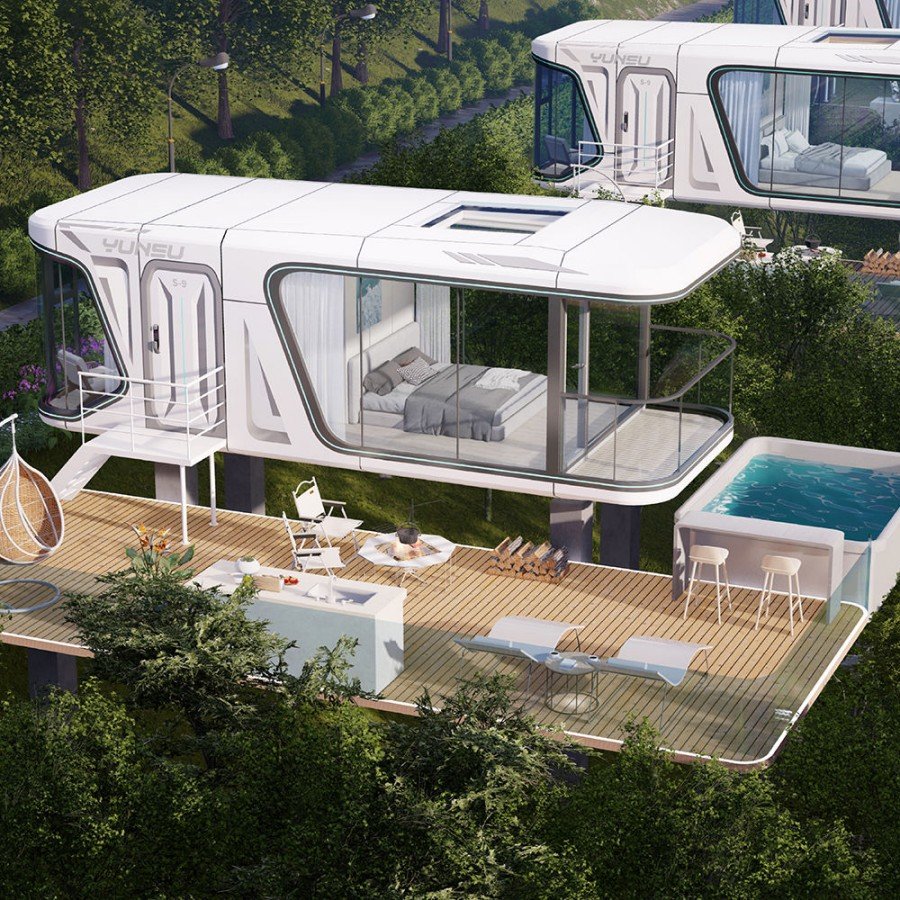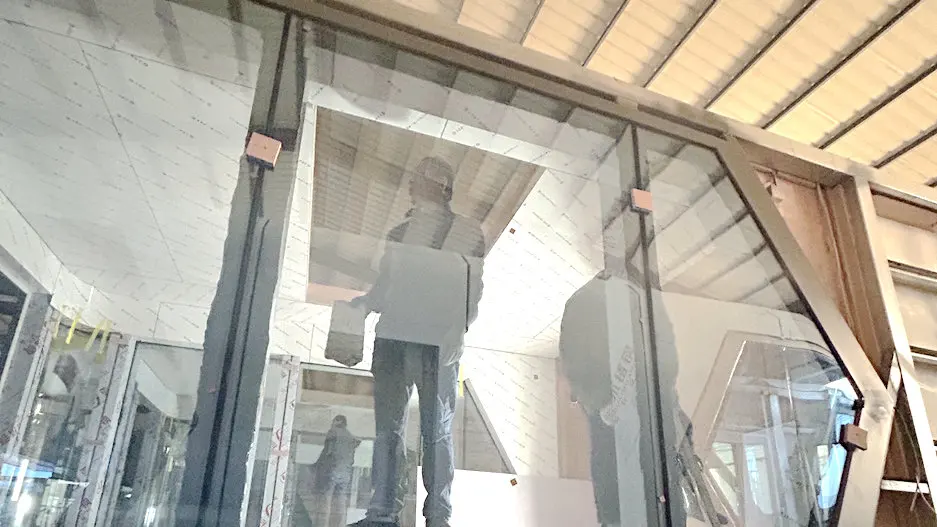The concept of capsule living is gaining popularity as a unique and efficient approach to modern housing. However, for those considering a capsule house in a hot climate, a natural and important question arises: can these compact structures truly stand up to extreme heat and provide comfortable living conditions?
Capsule houses are indeed proving to be highly suitable for hot climates. Thanks to their thoughtful design incorporating advanced insulation, natural ventilation strategies, and reflective exteriors, they are built to maintain comfortable interior temperatures and achieve energy efficiency, even when external conditions are challenging.
In this article, we’ll delve into the specific design features, essential materials, and compelling case studies that demonstrate how capsule houses can provide comfort and energy efficiency in hot regions.

1) Key Design Features for Heat‑Resistant Capsule Houses
Capsule houses are constructed to remain cool during hot weather. In this section, we will discuss the key design elements that make them ideal for hot weather:
i) Advanced Thermal Insulation
To keep heat out, capsule houses make use of materials such as polyurethane foam and EPS/XPS panels. In addition to the protective layers of insulation, the materials’ foamy structure also helps block hot air from coming in. Further, they help to maintain cool temperatures inside the capsule house.
This can be compared to the cooler bags we use to store drinks. Similarly, the insulation keeps the temperature steady even when it’s hot outside.
ii) Passive Cooling & Natural Ventilation
These homes feature windows, vents, and louvers that permit the inflow of cool air while enabling the outflow of warmer air. This facilitates air circulation within the house and helps in the reduction of temperatures. Cross ventilation and the stack effect incur a lesser dependence on air conditioning because warm air is able to leave the house naturally.
It is similar to the practice of opening windows at your residence to allow for cool breezes to enter without the use of a fan or air conditioning.
iii) Reflective and Radiant Barrier Exteriors
Capsule houses feature lightweight, reflective, and sometimes radiant barrier-clad aluminum, which assists in the reflection of sunlight. As a result, the capsule house remains cooler because it does not absorb excessive heat from the sun’s rays. Furthermore, these are solar control coatings that slow the flow of heat into a structure underneath the roof.
This is quite like when you put a light t-shirt on a sunny day; wearing such a shirt keeps you cooler than if you put on a dark one.

2) Essential Materials for Capsule Houses in Hot Regions
In warm regions, preventing overheating in your capsule house is very critical. This is the main reason for using the right insulation materials. Now, we will explore the material used in the capsule house in hot regions:
a) Insulation Materials That Withstand High Temperatures
The right materials prevent external heat from penetrating, so that the interior is cooler and more comfortable even when the sun’s rays are too much.
- Polyurethane Foam: This is one of the widely accepted forms of thermal insulation for building of capsule house. Because it is a plastic-based material, it must have fire fire-resistant covering to be used safely. It is best suited for use in wall panels or beneath the roof.
- Mineral Wool: The eco-friendly yet durable attribute of mineral wool is that it is composed of natural rock or recycled materials. It is particularly useful in very hot regions because of its ability to withstand high temperatures and resist fire. In addition, it does not tend to absorb moisture, which is advantageous in dry and dusty regions where dirt and sand can infiltrate everything.
- Rigid Foam Boards (EPS or XPS): This type of foam board is quite rigid, having satisfactory insulation properties. XPS (extruded polystyrene) and EPS (expanded polystyrene) offer solid thermal insulation for a very low cost. Most often, these boards are installed within the walls as an additional layer of thermal insulation to help cool the building.
b) High‑Performance Windows & Doors
Windows and doors can easily let in heat, so capsule houses use special ones that reduce heat transfer:
Low-E glass (Low-emissivity): In Low-E glass, its coating reflects heat but allows light in. The use of Double and Triple glazing further enhances passive heating as it contains two or three glass layers with air or gas in between.

- Thermal-break frames: These are window or door frames made with a special layer that stops heat from passing through. It’s like a barrier that keeps the metal from getting too hot and transferring heat inside.
c) Durable, Heat‑Resistant Structural Components
In hot regions, the outer components of your capsule house need to be robust and shielded from heat. Extreme sunlight may lead to materials warping, cracking, or deteriorating too quickly if the proper materials are not used.
- Corten steel or galvanized steel: They can withstand extreme heat. Corten Steel rusts more slowly because it forms a special surface layer, making it a good candidate for the outdoors. Galvanized Steel has a zinc coating that prevents rusting. This means they will not crack and break during the day when the temperatures are hot, and cooler during the night.
- Aviation-grade aluminum composite panels: They are called aviation-grade because aluminum is used in airplanes. They tend to be super lightweight, which is good, but also very strong. They don’t get damaged easily under high heat and won’t warp or bend even if the sun is beating on them all day.
3) Case Studies About Capsule Houses Thriving in Extreme Heat
After analyzing the phenomenon of capsule houses within the context of extremely hot climates, let us consider a few relevant real-life examples.
i) Desert Deployments
In locations like the Middle East and Australia, capsule houses have been field-tested against the scorching sun and heat. Though outdoor temperatures can exceed 110°F (43°C), good insulation with reflective materials keeps the interior of the capsule house cooler than 80°F (27°C).
Even in the example of lower cooling, the capsule house can still be lived in comfortably. These examples demonstrate the efficiency of capsule houses in hot and dry desert conditions.

ii) Tropical and Humid Environments
The implementation of capsule houses has been remarkably successful in hot and humid regions, such as Southeast Asia, with an average temperature of 88–95°F (31–35°C) and humidity surpassing 80%. People living in capsule houses in this area claim that natural airflow systems like openable windows, cross-ventilation, and roof vents greatly improve comfort.
Research conducted in the tropical region shows that well-designed capsule houses maintain an internal temperature of 7-10°F (4-6°C) lower than outside temperature, even in the absence of air conditioning.
4) Overcoming Hot Climate Challenges
Capsule houses are built to handle the challenges of hot weather. Here we will discuss how you tackle common problems related to extreme heat:
i) Managing Cooling Energy Consumption
It is very important to keep the capsule house cool in hot regions without racking up energy expenses. This is the reason why most designs incorporate HVAC units. With smart thermostats, you can control the temperature better, reducing power waste. Furthermore, the addition of solar panels or the utilization of shaded spaces can considerably lower electricity expenses.
ii) Preventing Moisture and Condensation
Too hot and humid conditions may cause moisture in your capsule house, and this can result in mold or rust. Using barrier vapor, dehumidifiers, and proper sealing of the walls and the roof will help eliminate the issue. The above measures will also protect your health and your home.
iii) Customizing Capsule Houses for Local Conditions
You can adjust your capsule house to match your local weather. For instance, making the roof overhangs larger can help block direct sunlight from hitting the windows in regions of the sunniest places on Earth, like Phoenix, Arizona. This enables the home to remain significantly cooler during the day.

In tropical regions such as Bangkok, Thailand, installing window shades or louvers not only provides heat and glare control, but also allows breezes to flow through. Plus, in other regions where the heat persists for long durations, thicker insulation in the walls and roofs bolsters heat retention, which preserves cooler inside temperatures.
Conclusion
In a nutshell, capsule houses can work well in hot climates. They use thick insulation, which blocks heat, and natural airflow further aids in cooling the interiors. Additionally, the reflection of heat from the sun is minimized by the capsule house’s exterior. Moreover, the smart cooling system optimizes energy consumption. With proper moisture control and climate-based design, your capsule house can remain cool, dry, and comfortable even in intense heat.
At Space Capsule House, we build custom capsule houses that are strong, energy-efficient, and perfect for hot climates. Get in touch with us today for more information and to get your own heat-resistant capsule house.


